Download Class 7 Science Transportation in Animals and Plants Notes Set B in PDF format. All Revision notes for Class 7 Science have been designed as per the latest syllabus and updated chapters given in your textbook for Science in Class 7. Our teachers have designed these concept notes for the benefit of Class 7 students. You should use these chapter wise notes for revision on daily basis. These study notes can also be used for learning each chapter and its important and difficult topics or revision just before your exams to help you get better scores in upcoming examinations, You can also use Printable notes for Class 7 Science for faster revision of difficult topics and get higher rank. After reading these notes also refer to MCQ questions for Class 7 Science given on studiestoday
Revision Notes for Class 7 Science Chapter 11 Transportation in Animals and Plants
Class 7 Science students should refer to the following concepts and notes for Chapter 11 Transportation in Animals and Plants in Class 7. These exam notes for Class 7 Science will be very useful for upcoming class tests and examinations and help you to score good marks
Chapter 11 Transportation in Animals and Plants Notes Class 7 Science
Plants & animals both required food for; air & water for the maintenance & breeding of a cell. Each has to be supplied to the cell of the body in a right quantity .
The transport of material in plants is carried out by the vascular tissue.
Vascular Tissue :
There are 2 types of vascular tissues found in plants
- Xylem : Xylem transport water & nutrient upwards from the roots to the leave. Evaporation of water from the leaves during transpiration produces a pulling force causing water to move up
- Phloem : It carry the food prepared by the leaves during photosynthesis downward to all parts of the plants.
Transportation of water, minerals & food :
- The roots have root hairs which increase the surface area of the root for absorption of water & minerals dissolved in water. The root hair come in contact with water present between soil particles.
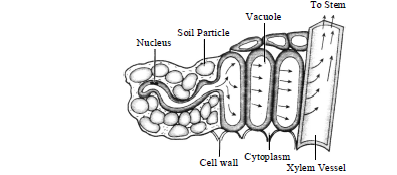
Traspiration pulls :
- The water move from the root hair to the xylem in the root. The absorbed water then moves up the stem through the xylem by the force developed in the leaves by the transpiration, called transpiration pull.
Ascent of sap :
- The fluid containing water & dissolved nutrient is called sap. The movement of sap through the xylem is called ascent of sap
Translocation :
- The food is transported from the leaves to other parts of the plant, called translocation.
EXCRETION IN PLANT
- Plants have no special organs for excretion. The excess amount of CO2 & water removed out through stomata also from the outer surface of stem, leave, fruit etc.
- Some waste products are colleced in vacuoles in the leaves & bark of trees & excrete them by shedding the leaves & barks
- Some waste products which are harmless, stored inside the plant body. Rubber raphides are examples of such products.
TRANSPIRATION
The process of loss of water in the form of vapours through the aerial parts of the plant is called transpiration.
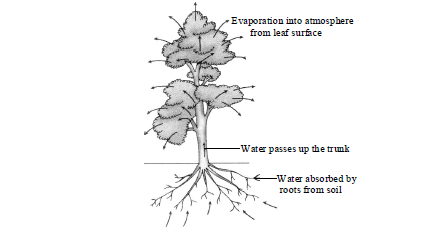
TRANSPORTATION IN ANIMALS
In higher animals, digested food, gases & waste material are carried by blood. Blood flows through a network of tubes, which are called blood vessles & form a system known as circulatory system.
CIRCULATORY SYSTEM
It consist of heart, blood vessels & the blood.
Heart :
- It is a muscular organ, which pumps blood around the blood vessels.
- It has four chambers viz left auricle, left ventricle, right auricle and right ventricle.
- Ventricles are the two lower chambers. The left ventricle receives blood from the left auricle and pumps up into aorta. Aorta is the largest artery in the body.
- The right ventricle receives blood from the right auricle and pumps it through pulmonary trunk of the lungs.
- The four chamber open and close about 100000 times a day.
- Heartbeat that we can hear is due to contraction and relaxation of heart muscles or cardiac muscles. Heart in a healthy body beats around 72 times in a minute.
- Contraction is held in auricles and relaxation is done in ventricles.
- Contraction of cardiac muscles is called systole and relaxation of cardiac muscle is called diastole.
- During diastole, heart receives blood and during systole, ventricles contract to pump blood into blood vessels.
- Sound of heartbeat is called ‘Lub-dub’ sound. ‘Lub’ is due to contraction of ventricles and ‘dub’ is due to closer of auricle valves.
- The heartbeat is measured by an instrument called ‘stethoscope’. A device makes the sound of heartbeat large. Noting of pulse rate is noting the number of times heart beats in a minute.
Blood vessels :
- These are blood-filled tubes.
- Arteries, veins and capillaries called blood vessels.

Arteries :
- Arteries are thick walled blood vessels, making up the arterial system and carrying blood away from the heart.
- Smaller arteries are called arterioles.
- Arterioles are branched off from arteries.
- Except in the pulmonary arteries, the blood contains oxygen.
- In all arteries, blood carries dissolved food and waste, brought into the heart by veins and is then transferred to arteries.
- Arteries carry the food to the cells and waste to the kidneys.
Veins :
- Veins are wide, thick walled, blood vessels.
- Veins make the venous system and carries blood back to the heart.
- Small veins are called venules.
- Veins contain valves to stop blood flowing backwards due to gravity and are formed of merging venules
- The blood in the veins leading from the digestive system and liver also carries dissolved food. This is transferred to the arteries in the heart.
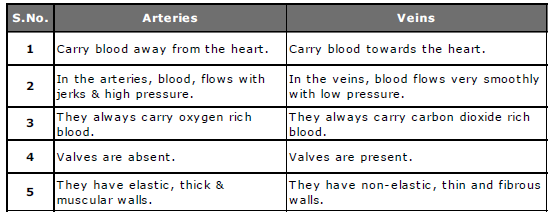
Capillaries :
- Narrow, thin walled blood vessels branching off arterioles to form a complex network is called capillaries.
- Dissolved food and oxygen pass out through the walls of capillaries to the body cells and carbon dioxide and waste pass in
- The capillaries of the digestive organs and liver also pick up food
- Finally, capillaries join up to form small veins called venules
Blood :
- It is a connective tissue in fluid form
- An adult human has around 5.5 litres of blood
- A red fluid flows in the body
- It supplies food and oxygen to every body cell
- It removes wastes from the cells
- It regulates body temperature
- It protects against infection
CONSTITUENT OF BLOOD
RBC (Red Blood Corpuscles) :
- This is also called erythrocytes.
- RBC is a red disc shaped cells with no nuclei.
- They are made in the bone marrow and contain haemoglobin (an iron compound that gives blood a dark red colour).
- RBC combines with oxygen to form oxy-haemoglobin and the blood becomes bright red.
- The red cells pass the oxygen to the body cells by the process of diffusion and then returns to the – lungs with haemoglobin.
WBC (White Blood Corpuscles) :
- This is also called leucocytes.
- WBC is large, opaque blood cells, which helps in body defence.
- WBC makes antibodies. Antibodies produce antigens, which combat against any bacterial or viral infection. Antigens are mostly protein.
Plasma :
- It is a pale liquid with 90% water in it.
- Plasma contains the blood cells.
- Plasma carries dissolved food for the body cells, waste matter, and carbon dioxide secreted by them.
Platelets :
- It is also called thrombocytes.
- It is a very small, disc shaped bodies with no nuclei.
- It is made in the bone marrow.
- They gather particularly in an injured area, where they are important in clotting the blood.
REMOVAL OF WASTE
The process of removing waste from the body is called excretion Several organs of body is involved in the process of excretion –
- The waste generated in the process of digestion is expelled from the large intestine through anus.
- Carbon dioxide produced in the process of respiration is expelled from the lungs through the nostrils.
EXCRETION IN HUMANS
Chemical waste like urea are excreted by urinary system & skin.The excretory system in human beings consists of the following organs:
– A pair of kidneys
– A pair of ureters
– The urinary bladder
– Urethra
Urinary system or Excretory system :
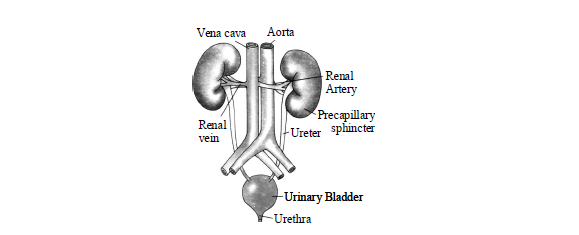
- Kidneys :
In our body there is a pair of kidneys located in the abdomen, one each on either side of the vertebral column. Each kidney is brick red in colour and bean-shaped. It weighs about 150 g and is about 12 cm in length, 6 cm in width and 3 cm in thickness
- Uterers :
The ureters are two thin-walled, urine carrying ducts. A ureter originates from each kidney and is about 30 cm in length. The ureters run downward and open into the urinary bladder
- Urinary Bladder :
It is a bag-like structure in which urine is stored. Its size and position varies with the amount of urine it contains.
- Urethra :
The urethra is the duct which finally discharges urine from the body
Function of Kidney
- They filter wastes from the blood
- They help in the formation of urine
- They help in eliminating harmful substances from the body.
- They maintain the water and mineral balance in the body.
Skin :
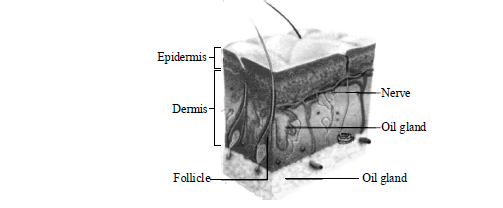
- Skin is the outer body covering of human body. It is made up of several tissue layers cushioned by fats underneath.
- Skin has many functions. Skin provides stimulation, protects against infection, prevents from drying out, regulates body temperature, stores fat, makes vitamin D, and above all excretes waste such as sweat.
CBSE Class 7 Science Chapter 11 Transportation in Animals and Plants Notes
We hope you liked the above notes for topic Chapter 11 Transportation in Animals and Plants which has been designed as per the latest syllabus for Class 7 Science released by CBSE. Students of Class 7 should download and practice the above notes for Class 7 Science regularly. All revision notes have been designed for Science by referring to the most important topics which the students should learn to get better marks in examinations. Our team of expert teachers have referred to the NCERT book for Class 7 Science to design the Science Class 7 notes. After reading the notes which have been developed as per the latest books also refer to the NCERT solutions for Class 7 Science provided by our teachers. We have also provided a lot of MCQ questions for Class 7 Science in the notes so that you can learn the concepts and also solve questions relating to the topics. We have also provided a lot of Worksheets for Class 7 Science which you can use to further make yourself stronger in Science.
You can download notes for Class 7 Science Chapter 11 Transportation in Animals and Plants for latest academic session from StudiesToday.com
Yes, the notes issued for Class 7 Science Chapter 11 Transportation in Animals and Plants have been made available here for latest CBSE session
There is no charge for the notes for CBSE Class 7 Science Chapter 11 Transportation in Animals and Plants, you can download everything free of charge
www.studiestoday.com is the best website from which you can download latest notes for Chapter 11 Transportation in Animals and Plants Science Class 7
Come to StudiesToday.com to get best quality topic wise notes for Class 7 Science Chapter 11 Transportation in Animals and Plants

